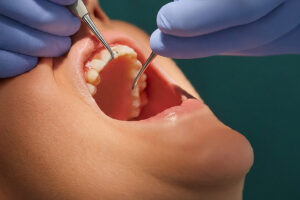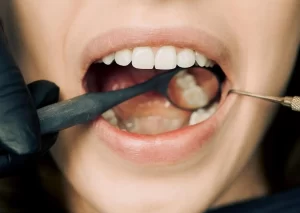Throbbing Pain after Tooth Extraction, But Not Dry Socket

Are you’re experiencing throbbing pain after a tooth extraction, and you believe it’s not a dry socket?
Some level of pain and discomfort is expected after a tooth extraction. This is due to the inflammation and healing process. There are some differences between normal post-extraction pain and more serious complications.
Table of Contents
Dry Socket vs. other complications
Dry Socket
This condition occurs when the blood clot that forms in the socket (the hole in the bone where the tooth was) is dislodged or dissolves before the wound has healed, exposing the bone and nerves.
Dry socket typically causes a severe, persistent pain that starts a few days after extraction and doesn’t improve with over-the-counter medication. It’s often accompanied by a bad taste or smell from the extraction site.
Other complications
Throbbing pain not associated with dry socket could be due to other factors, such as:
- Residual bone fragments: Small pieces of bone left behind after the extraction can cause discomfort until they are removed or become integrated.
- Damage to surrounding areas: Sometimes, the extraction can cause trauma to nearby teeth or tissues, leading to temporary pain.
- Nerve injury: Very rarely, a nerve close to the extraction site can be bruised or damaged during the procedure, leading to pain or numbness.
Signs of normal healing pain vs complications like Dry Socket
Normal Post-Extraction Pain
- Normal Healing Process: Some degree of pain and discomfort is normal after a tooth extraction as part of the healing process. This can last for a few days and is usually manageable with over-the-counter pain relievers.
- Inflammation: After an extraction, inflammation is the body’s natural response. This can result in pain, which is often at its peak within the first 48-72 hours.
Potential Complications
- Dry socket: Throbbing pain that starts 3-5 days after extraction, often described as intense and radiating. Bad breath and exposed bone in the socket are common.
- Infection: While less common, an infection can occur after an extraction, leading to increased pain, swelling, and possibly fever. Unlike dry socket, an infection is usually accompanied by noticeable swelling and redness.
- Nerve injury: Numbness or tingling in the area, usually temporary but can be permanent.
Since you suspect it’s not a dry socket, seek professional advice if:
- The pain is severe and doesn’t improve with medication.
- You experience any additional worrying symptoms like fever, swelling, or pus.
- The pain lasts longer than a week.
Signs the severe pain after tooth extraction is a Dry Socket
Dry socket, known medically as alveolar osteitis, is a painful condition that can occur after a tooth extraction when the blood clot that forms in the socket to promote healing is dislodged or dissolves before the wound has healed. This leaves the underlying bone and nerves exposed to air, food, fluid, and bacteria, leading to intense pain.
Here are key indicators that the severe pain you’re experiencing after an extraction might be due to dry socket:
- Timing of Pain – Dry socket typically develops 2 to 4 days after the tooth extraction. If your pain suddenly intensifies after a period of relative comfort, it could be a sign of dry socket.
- Nature of Pain – The pain associated with dry socket is often described as throbbing, sharp, or intense. It can be severe enough to disrupt sleep and daily activities.
- Location of Pain – The pain may not be limited to the extraction site. It can radiate to your ear, eye, temple, or neck on the same side of your face as the extraction.
- Visible Bone in the Socket – If you look into the mirror and examine the site of the extraction, you might see that the socket appears empty, dry, or partially filled with a whitish, grayish material, indicating exposed bone instead of a dark blood clot.
- Bad Breath or Unpleasant Taste – A noticeable bad breath or a persistent unpleasant taste in your mouth, despite maintaining oral hygiene, can be indicative of dry socket.
- Absence of Expected Healing Signs – If the extraction site doesn’t seem to be healing and the typical signs of healing (such as the formation of a healthy clot) are absent, this could be a sign of dry socket.
- Swollen Lymph Nodes Around the Jaw or Neck – While not as common, swollen lymph nodes around your jaw or neck can indicate an infection or inflammation, such as from dry socket.
- Slight Fever – In some cases, dry socket can be accompanied by a slight fever as a response to the inflammation or potential infection.
What to Do If You Suspect Dry Socket
If you suspect you have dry socket, it’s important to contact your dentist or oral surgeon as soon as possible. Treatment typically involves:
- Cleaning the Socket: Removing debris from the socket to reduce the risk of infection.
- Medicated Dressings: Placing medicated dressings in the socket to protect it and reduce pain. These dressings may need to be replaced every few days.
- Pain Management: Prescribing or recommending pain relievers to help manage the discomfort.
- Antibiotics: In some cases, especially if there’s an infection, antibiotics may be prescribed.
Managing pain
- Follow Post-Operative Instructions: Carefully follow your dentist’s or oral surgeon’s instructions for post-operative care. This often includes rest, avoiding certain foods, and not smoking.
- Pain Management: Use the prescribed pain relievers or over-the-counter options like ibuprofen or acetaminophen. Applying a cold pack to the cheek can also help reduce swelling and pain.
- Oral Hygiene: Keep the area clean according to the instructions provided by your healthcare provider. This may include gentle rinsing with salt water after the first 24 hours.
- Monitor Symptoms: If your pain worsens, spreads, or is accompanied by swelling, fever, or foul taste, contact your dentist. These could be signs of infection or other complications that require professional attention.
Prompt treatment can significantly alleviate pain and accelerate healing. Following your dentist’s advice for post-extraction care is crucial for preventing dry socket and other complications.
FAQ
Why am I having throbbing pain 5 days after tooth extraction?
Throbbing pain 5 days after tooth extraction could be due to the normal healing process, where inflammation and tissue repair cause discomfort. It might also indicate complications like infection, dry socket, or irritation from residual bone fragments. If the pain is severe, worsening, or accompanied by other symptoms like fever or bad taste, it’s important to consult your dentist to rule out these issues and ensure proper healing.
What causes prolonged pain after tooth extraction?
Prolonged pain after tooth extraction can be caused by several factors, including dry socket, where the protective blood clot is dislodged, exposing bone and nerves; infection at the extraction site, leading to increased pain, swelling, and possibly fever; damage to surrounding tissues or teeth during the extraction; or a slow healing process, particularly in individuals with compromised immune systems or those who do not follow post-operative care instructions.
Why do I still have nerve pain after tooth extraction?
Nerve pain after tooth extraction can persist if a nerve was bruised, stretched, or damaged during the procedure, particularly the inferior alveolar nerve, which can affect sensation in the lower lip, chin, and teeth. This type of nerve injury can result in pain, tingling, numbness, or a burning sensation.
How can you tell the difference between dry socket and normal pain?
Dry socket pain typically emerges 3-5 days post-extraction, is severe, and doesn’t improve with over-the-counter painkillers, unlike normal pain which peaks within 48-72 hours and gradually lessens. Dry socket may also present with a visible empty socket, exposed bone, and possibly a foul odor or taste, which are not characteristics of normal healing pain. Normal post-extraction pain is manageable with medication and improves steadily, without the distinctive symptoms of dry socket such as radiating pain to the jaw, ear, or neck on the affected side.
How long SHOULD I have pain after tooth extraction?
It’s normal to experience pain for up to 3-7 days after a tooth extraction. This pain should gradually decrease as the healing process progresses. Beyond this period, while some mild discomfort may persist for up to two weeks, especially after complex extractions, any severe, worsening, or prolonged pain warrants a consultation with your dentist to rule out complications like infection or dry socket. Pain management with prescribed or over-the-counter pain relievers, along with proper aftercare, is crucial for a smooth recovery.
Fact Checked
Our dedicated team rigorously evaluates every article and guide to ensure the information is factual, up-to-date, and free of bias.
Updated Regularly
We update our articles and reviews regularly to ensure you have access to the latest data in the dental industry.
The content on Dental3DU’s blog is intended for educational purposes only. This information should not be relied upon as professional medical counsel. Be sure to always consult with your dentist about the dangers and benefits of any medication, treatment or procedure.







